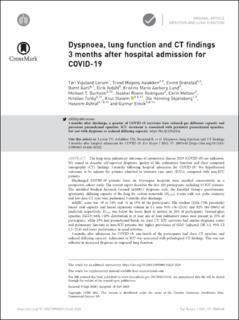| dc.contributor.author | Lerum, Tøri Vigeland | |
| dc.contributor.author | Aaløkken, Trond M | |
| dc.contributor.author | Brønstad, Eivind | |
| dc.contributor.author | Aarli, Bernt Bøgvald | |
| dc.contributor.author | Ikdahl, Eirik | |
| dc.contributor.author | Lund, Kristine Marie Aarberg | |
| dc.contributor.author | Durheim, Michael | |
| dc.contributor.author | Rivero, Jezabel Rodriguez | |
| dc.contributor.author | Meltzer, Carin | |
| dc.contributor.author | Tonby, Kristian | |
| dc.contributor.author | Stavem, Knut | |
| dc.contributor.author | Skjønsberg, Ole Henning | |
| dc.contributor.author | Ashraf, Haseem | |
| dc.contributor.author | Einvik, Gunnar | |
| dc.date.accessioned | 2021-09-10T12:08:25Z | |
| dc.date.available | 2021-09-10T12:08:25Z | |
| dc.date.created | 2020-12-18T12:05:00Z | |
| dc.date.issued | 2021 | |
| dc.identifier.issn | 0903-1936 | |
| dc.identifier.uri | https://hdl.handle.net/11250/2775235 | |
| dc.description.abstract | The long-term pulmonary outcomes of coronavirus disease 2019 (COVID-19) are unknown. We aimed to describe self-reported dyspnoea, quality of life, pulmonary function and chest computed tomography (CT) findings 3 months following hospital admission for COVID-19. We hypothesised outcomes to be inferior for patients admitted to intensive care units (ICUs), compared with non-ICU patients.
Discharged COVID-19 patients from six Norwegian hospitals were enrolled consecutively in a prospective cohort study. The current report describes the first 103 participants, including 15 ICU patients. The modified Medical Research Council (mMRC) dyspnoea scale, the EuroQol Group's questionnaire, spirometry, diffusing capacity of the lung for carbon monoxide (DLCO), 6-min walk test, pulse oximetry and low-dose CT scan were performed 3 months after discharge.
mMRC score was >0 in 54% and >1 in 19% of the participants. The median (25th–75th percentile) forced vital capacity and forced expiratory volume in 1 s were 94% (76–121%) and 92% (84–106%) of predicted, respectively. DLCO was below the lower limit of normal in 24% of participants. Ground-glass opacities (GGO) with >10% distribution in at least one of four pulmonary zones were present in 25% of participants, while 19% had parenchymal bands on chest CT. ICU survivors had similar dyspnoea scores and pulmonary function as non-ICU patients, but higher prevalence of GGO (adjusted OR 4.2, 95% CI 1.1–15.6) and lower performance in usual activities.
3 months after admission for COVID-19, one-fourth of the participants had chest CT opacities and reduced diffusing capacity. Admission to ICU was associated with pathological CT findings. This was not reflected in increased dyspnoea or impaired lung function. | en_US |
| dc.language.iso | eng | en_US |
| dc.publisher | European Respiratory Society | en_US |
| dc.rights | Navngivelse-Ikkekommersiell 4.0 Internasjonal | * |
| dc.rights.uri | http://creativecommons.org/licenses/by-nc/4.0/deed.no | * |
| dc.title | Dyspnea, lung function and CT findings three months after hospital admission for COVID-19 | en_US |
| dc.type | Journal article | en_US |
| dc.type | Peer reviewed | en_US |
| dc.description.version | publishedVersion | en_US |
| dc.rights.holder | Copyright European Respiratory Society 2021 | en_US |
| dc.source.articlenumber | 2003448 | en_US |
| cristin.ispublished | true | |
| cristin.fulltext | postprint | |
| cristin.qualitycode | 2 | |
| dc.identifier.doi | https://doi.org/10.1183/13993003.03448-2020 | |
| dc.identifier.cristin | 1861525 | |
| dc.source.journal | European Respiratory Journal | en_US |
| dc.identifier.citation | European Respiratory Journal. 2021, 57, 2003448. | en_US |
| dc.source.volume | 57 | en_US |

